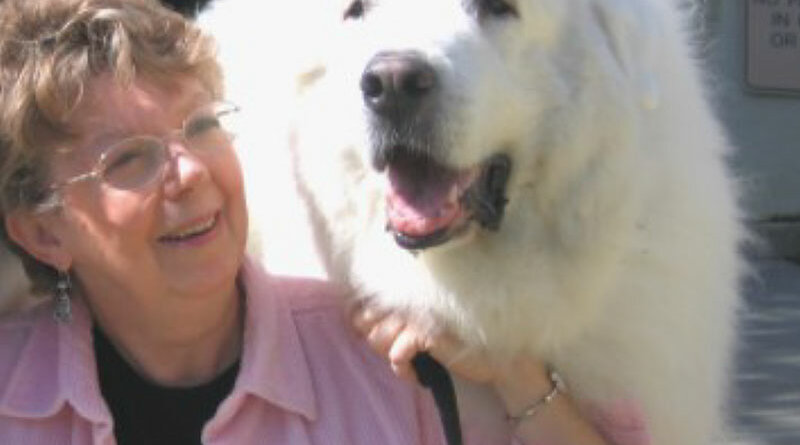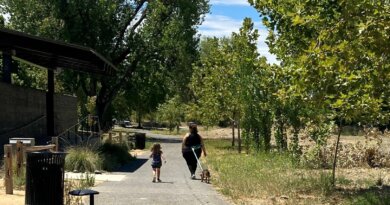Zen and the Art of Animal-Assisted Therapy
When Kolya, a Great Pyrenees, ambled through the corridors of the UCLA Medical Center wearing his blue-and-gold scarf and People-Animal Connection (PAC) therapy dog ID, he stopped traffic. Patients, visitors, nurses and doctors halted in their tracks to stare at his 150 pounds of calm, laid-back whiteness. Children wondered if he was a dog or a small pony. Should they pet him or ride him?
Betty Walsh, a volunteer, led her dog on a loose lead as they walked, allowing him to proceed at his deliberate, relaxed, rocking pace. As the pair moved slowly through the hospital corridors, she stopped and allowed everyone to admire, pet and meet Kolya. It often took her 30 minutes to get to the elevator.
In contrast, my Golden Retriever and team partner, Holly Go Lightly, actively solicited responses from everyone she met in an energetic “Hey, notice me” style. At the time, I was a PAC program consultant, teaching volunteer teams how to work effectively with psychiatric populations. This was different from a bed-visit in hospital units, where the therapy dogs lie on the bed, cuddle with patients and don’t require a repertoire of behaviors. In neuropsychiatric units, the patients were not sedentary; they needed a program.
Holly recognized and responded to more than 20 verbal commands and hand signals and would perform them for anyone I handed her lead to. Patients developed self-confidence as she responded to all their commands. In adolescent psychiatry, this was life-changing. The young people rewarded Holly with treats or a “good girl” and a hug around the neck. They learned that we all need affection and praise as well as treats. When they rewarded her behaviors, it translated to their own success. When they thanked her, they were thanking themselves for doing such a good job of training.
GET THE BARK NEWSLETTER IN YOUR INBOX!
Sign up and get the answers to your questions.
By appointment, Betty came without Kolya to observe a demonstration session with Holly in the adolescent psychiatry unit. Staff and kids sat in a circle and applauded each behavior she performed as she responded correctly to my hand signals and verbal cues: roll over, speak, paws up, back, sit, down, stay, come, heel and more. They watched intently, as each would soon have a turn to work with the dog.
Betty sat on the sofa, smiling throughout this demonstration of therapy skills. After Holly completed her entire program, working with each child in the unit, Betty said (with a serious face), “My dog can’t do any of that.”
I tried to encourage her. “Oh, there are behaviors I’m sure he knows.” Betty thought a moment, and then said, “No, not really.”
“What does he do? He comes when you call him, doesn’t he?” I asked.
“Sometimes” she answered.
Still undiscouraged, I said, “Well, he can sit or lie down, can’t he?”
“If he wants to,” she said again. I couldn’t believe this.
“We’ll figure out a program for him, don’t worry,” I assured her. Of course, I had yet to meet her dog.
Betty and Kolya were assigned to the child psychiatry unit, with children ages three to nine. Now it was my turn to observe her session and guide her to develop the best treatment plan using animal-assisted therapy. We walked into a small room, not nearly large enough to accomplish the kind of interaction I used with teenagers, who had space to “heel” Holly all over the room.
About seven youngsters sat at a table painting picture frames; the frames would hold each child’s photo with Kolya. One boy yelled and smacked the child next to him. Another child threw his paint dish across the room, splattering red paint on the walls. One child was crying. A tiny girl hid her face with her hands. Two therapists were present to manage the children.
Betty brought the large dog into the room, where he plopped down on the cool linoleum near the door. And there he lay. Oh no, I thought, watching this. How will we ever get this dog to interact with these young kids if he just lies there?
The child who was throwing paint now started painting designs on the picture frame. He worked feverishly, standing up to do so. The one who was crying, stopped. The girl hiding her face peeked between her fingers to watch the big white dog on the floor.
When the children finished painting, the therapists asked them to visit the dog. And visit him they did. All seven lay on top of Kolya, covering him from head to tail with their bodies. And they petted. And they cooed. And they kissed.
And Kolya? Why, he just lay there, just as Betty had said. He did nothing. But in that nothing, there was a relaxed, calm energy; there was power. He accepted the children who were draped all over him. My mouth dropped open in astonishment. I had never seen a dog tolerate so many intrusions at once.
He never blinked. He just lay there quietly and contentedly, allowing this collection of hands, feet and heads to touch, rub and hug him. Within seconds, the normally agitated children became as calm as the enormous dog.
One of the therapists said, “This is better than medication.”
I wrote treatment plans for all of the teams I worked with. Usually, I made recommendations as to how the volunteer could improve the visits. When I wrote up my report describing the goals, strategies and outcomes of this session with Betty and Kolya, I described children who had been yelling out or striking others, or were hyperactive or withdrawn. I wrote one line in the recommendation section at the bottom of the page that said it all: “I cannot improve on this session.” The change in the affect of these children was dramatic. From hyperactivity and tantrums came peace and quiet and love.
The experience with Kolya also had an impact on me—on my need to be perfect, to do it all, to get it right, to have the perfect dog. I was able to recognize the great healing benefits of a dog who couldn’t do the program my way. Kolya did nothing. But just as in Buddhist philosophy, in that nothing, there was everything. For what he offered was love.
Postscript: Kolya died in 2005, but his kind heart remains forever in our memories. Kolya was the poster boy for media coverage of the PAC program. His size and gentle nature made him irresistible.





augmentin doses for sinusitis